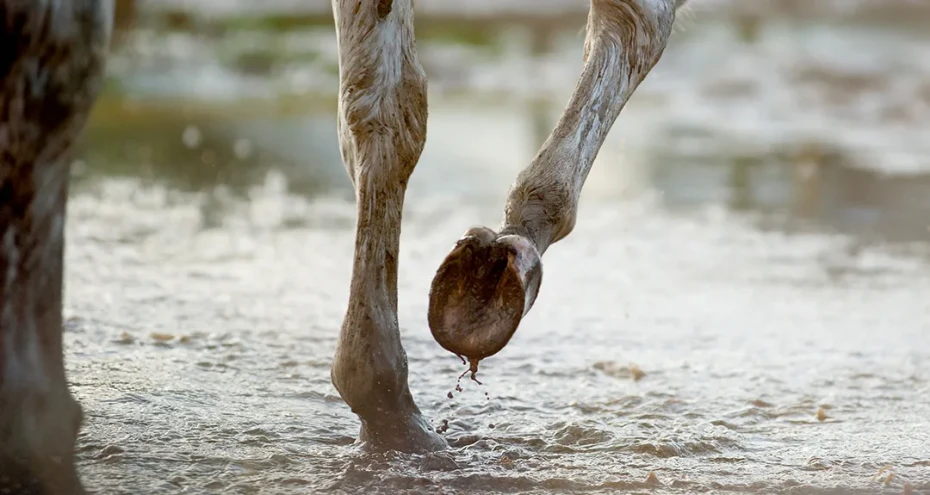
HOOF CARE: HOW THE WEATHER AFFECTS EQUINE FEET!
We are all too familiar with the old proverb “no foot, no horse” and it still couldn’t be truer today. Hoof health is indisputably important, as neglected hooves can lead to discomfort, pain, disfigurement and even lameness. But what effect did the dry summer have on our equines’ hooves?
Firstly, it is worth noting that a dry hoof is better than a wet hoof; excess moisture causes the bonds within the hooves’ molecular structures to weaken. It is said that hoof horn is strongest when it has a moisture content of around 25%; like our fingernails, which become flexible after a swim or a soak in the bath, hooves are strongest when dry.
There’s not much we can do about the dry weather of course, however certain management aspects can make its effects worse:
- Inactivity – a lack of exercise will compromise equine circulation and hoof integrity.
- A lack (or imbalance) of essential minerals and vitamins, and other key dietary requirements – hoof health starts from within.
- Poor shoeing or trimming – if these do not allow the hoof to function properly, environmental factors will be more influential.
What can we do about dry hooves?
Although opinion does vary on this matter, many farriers and trimmers believe it is inadvisable to completely drench horses’ feet with water for long periods, and that this is a dated school of thought. However, the simple act of bathing the horse in hot weather, when the water will trickle down and wet the hooves, or allowing the field water trough to overflow, so the horse stands in wet grass while he drinks, could be beneficial.
- Avoid painted-on hoof products. Topical hoof products, with a few exceptions, are generally not recommended, other than for cosmetic purposes, as they generally do not improve hoof integrity and may compromise the ‘breathing’ function of the hoof. Oil-based products in particular are thought to cause deterioration of the horn structure at molecular level, and undesirably ‘seal’ the hoof.
- Assess the diet. A balanced diet is vital to the condition of the hooves, and ensuring the horse has a forage-based diet that is low in sugar and starch, with appropriate levels of vitamins and minerals, is key. Minerals often lacking in the equine diet that are key ingredients for hoof health are Biotin, methionine, zinc (provided with copper), and Magnesium Oxide; but you can also have too much of a good thing, so it may be advisable to have your hay analyzed for deficiencies, so you can ensure you provide everything your horse needs for healthy feet in all conditions.
- Provide exercise to encourage circulation within the hoof. Mere turn out in a traditional field may not be enough – ideally the horse needs purposeful, regular activity. Creating a system of tracks instead of an easy-to-navigate square, to encourage maximum movement whilst foraging, is also an excellent way to increase everyday movement.
Many horse owners are now turning to barefoot hoof care as a long-term management regime. One benefit is that the hooves can expand and contract with the changing environmental conditions, without the restriction of shoes.
Shod hooves will often crack around nail holes, compromising the hoof capsule, which is also a concern. Hoof boots with comfort pads can be useful for the barefoot horse, for comfort and protection when transitioning from horse shoes, or for longer term use when the ground is particularly challenging.
For example, the Scoot Boot is a very lightweight and simple hoof boot, that represents the latest innovation in hoof boot technology. The Scoot hoof boot unlike other hoof boots will not get soggy, heavy or wet when riding through wet terrain as there are no material parts to hold moisture. The Scoot Boot is constructed of very strong thermo-plastic urethane (TPU) as well as the securing straps, which gives the Scoot Hoof Boot superb strength to stand up to all types of terrain that you and your horse may ride over.
The Scoot Comfort Pads are designed to be used only in the Scoot Boot hoof boots, and are for sensitive soles or to assist fitting in between sizes. Scoot boot recommend that for maximum security, you glue your Scoot pads into your Scoot Boots. This will extend the life of the pads and keep them in place. You can purchase a good plastic glue from your local hardware store!
 Saddle
Saddle
 Horse
Horse
 Dog
Dog
 Harness
Harness